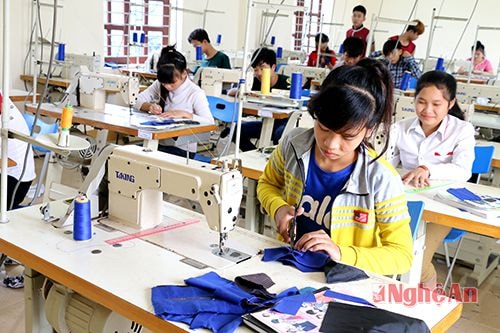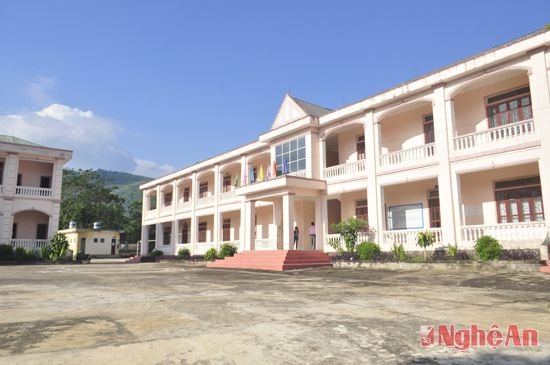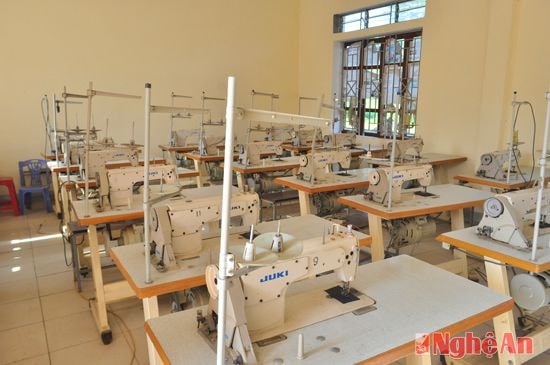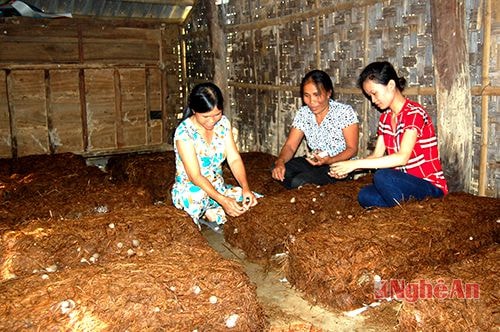Billions wasted at vocational training centers in mountainous districts
(Baonghean) - High-rise buildings with modern machinery, equipment and facilities at vocational training centers in mountainous districts are extremely wasteful because there are too few students.
Difficulty in recruiting, waste of facilities
Quy Chau District Vocational Training Center was built spaciously and modernly with a total investment of nearly 18 billion VND from the national target program and the provincial and district budgets. In addition to 3 spacious and modern high-rise buildings, machinery, equipment and facilities are also basically guaranteed to meet the needs of vocational training.
 |
| A sewing class at Quy Chau District Vocational Training Center. |
However, the center is currently facing difficulties in recruiting students. Mr. Pham Van Duong, Vice Principal of the school, shared: Each year, only a few classes are recruited. Since the beginning of 2015, only about 100 students have enrolled. The number of vocational training registrations is gradually decreasing over the years. Short-term vocational training classes are for vocational students in villages and hamlets, but have not attracted students in the stream or students who have graduated from high school. This really causes a great waste in the process of investing in facilities and teaching equipment.
At Que Phong District Vocational Training Center, the two-story building with a system of workshops for practicing sewing, welding, carpentry, electronics repair, civil electricity, and computers is also empty of students.
 |
| Que Phong district vocational training center has spacious and modern facilities. |
Each year, the center only organizes 1 to 2 sewing classes, and the training equipment at the center has gradually degraded over time.
Mr. Le Van Que, Director of Que Phong District Vocational Training Center, said: To effectively promote vocational training for the people, the center's staff must directly bring machinery to the grassroots to open mobile vocational training classes, but due to local customs and practices, people only like to go to the forest and fields to find things that can be eaten and sold immediately, and do not like to go to school, so opening classes is very limited.
In Tan Ky district, the district vocational training center is a 2-storey building with 12 classrooms and equipment for practicing electric welding, civil electricity, industrial sewing, and carpentry.
In 2010, the center opened 3 veterinary classes with 95 students; in 2012, the center opened 7 classes with 307 students. However, since then, the number of students has gradually decreased; on average, only about 180 - 200 students come to study each year. Since the beginning of 2015, the center has only opened 2 intermediate veterinary classes with 65 students.
Centers need to innovate themselves
It is undeniable that in recent years, vocational training in mountainous districts has had certain changes. From only 5 vocational training centers in 2005 in lowland districts, now all mountainous districts have vocational training centers and schools. In addition, many vocational training support programs for workers have been implemented. Every year, 10 mountainous districts have tens of thousands of young people leaving school, adding to the local labor force.
However, the rate of workers participating in vocational training is very modest. In 2014, the rate of workers receiving vocational training in mountainous districts reached 38%, significantly lower than the average rate of the whole province (46%).
 |
| The machinery system for teaching sewing is being wasted. |
According to leaders of vocational training centers, the biggest difficulty in vocational training for workers in mountainous areas, especially in highland districts, is that ethnic minorities prefer to work freely in their hometown fields and are not familiar with industrial-style labor; very few workers are willing to go to vocational training to work in factories. Another reason is that workers are confused and do not know what career to choose. Some students go to school with the mentality of receiving support...
However, it must be noted that, at present, vocational training centers in mountainous areas have not met the recruitment requirements of businesses; they are not sensitive to finding "output" for workers, while the vocational training time is too short so the skills of workers are not high. The vocational training structure for rural workers in local industries and fields is not really suitable. The centers are still focusing on non-agricultural occupations such as computer repair, electronics repair, welding; classes such as veterinary animal husbandry, brocade weaving, agricultural machinery repair are very few.
 |
| Mushroom production training class at Anh Son Vocational Training Center. Photo: Sy Thuan |
Mr. Dang Cao Thang - Deputy Director of the Department of Labor, War Invalids and Social Affairs, the demand for vocational training and career change of farmers in mountainous areas and ethnic minority areas is not high, but it does not mean that it does not exist. The problem is that training must be closely linked with job creation, linking training with businesses and society; training according to needs, according to clear addresses.
In addition, there should be an incentive system to attract vocational teachers to centers in mountainous areas, build a vocational structure based on production area planning so that after completing their studies, learners can find jobs immediately; diversify training types, at the same time strengthen propaganda, mobilization and have an incentive system for learners in the early stages to create a habit of wanting to approach new things, eliminate the mentality of dependence...
Minh Quan - My Ha
| RELATED NEWS |
|---|
